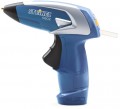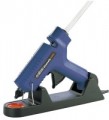Max. power consumption
The highest power consumed by the glue gun during operation. Usually, such power is required by the device for a short time, to warm up to operating temperatures; while maintaining the temperature, the energy consumption is much lower.
The higher the power consumption, the less, usually, the heating time (ceteris paribus); on the other hand, the consumption of electricity and the load on the power grid depend on this characteristic. However, even in the most high consumption models, the maximum power usually does not exceed 1 kW, which allows you to connect to a regular household outlet without any problems; and to estimate the heating time, it is better to look at the characteristics directly claimed by the manufacturer. As a matter of fact, data on maximum power consumption is rarely required in fact, usually when connected to a generator, stabilizer or other equipment where it is necessary to accurately estimate the load.
Operating power
The power consumed by the glue gun in the process of maintaining the operating temperature (in the presence of several temperature modes, it is indicated, usually, for the “hottest”). This indicator, usually, is several times less than the maximum power consumption (see above), so it is more of a reference than a practical value. High power allows you to achieve a good glue supply speed; however, models with the same power can vary markedly in performance.
Sticks length
The diameter of the glue stick for which the gun is designed.
For modern glue guns, rods of standard diameters are produced; the most popular options are
7,
8,
11 and
12 mm. Usually, the thicker the rod required for the job, the more powerful and performant the tool. However, exceptions are not uncommon: for example, there are 12 mm models with a very low glue supply rate. Therefore, in fact, this information is needed more to search for consumables than to assess the capabilities of the gun. At the same time, although some models are practically "omnivorous", it is still undesirable to deviate from the manufacturer's recommendations.
Sticks length
The length of the glue stick for which the gun is designed. In fact, we are talking about the optimal length: many models allow you to charge both longer and shorter rods, but it is most convenient when the length of the consumable corresponds to the manufacturer's recommendations.
Feed rate
The maximum glue flow rate that the gun can provide is, in fact, the peak performance of the tool.
In general, indicators up to 10 g / min can be attributed to low, up to 20 g / min — to medium, more than 20 g / min — to high. The larger the scale of the planned work, the higher the glue supply rate is desirable for them; on the other hand,
high performance may be overkill in cases where little adhesive is required. However, if the tool is bought for simple household tasks, this indicator can be ignored.
Heating time
The average time it takes the glue gun to reach operating temperature (in models with multiple modes, it is usually indicated for the maximum temperature). A more “fast” tool allows you to significantly save time; on the other hand,
rapid heating significantly affects the price and power consumption.
Max operating temperature
Most modern glue sticks melt at a temperature slightly above 100 °C, and a further increase in temperature only makes sense to increase the productivity of the gun: the higher it is, the faster the melting proceeds and the more liquid the glue turns out. There are also high-temperature grades of glue, but most modern pistols are quite capable of coping with them. Therefore, when choosing according to the operating temperature, it is worth considering first of all what materials are planned to be joined. So, for paper and some fabrics, a maximum of 105 – 110 °C is allowed, and with wood,
glue guns with a high melting point(200 °C and above) can be used without problems. More detailed recommendations can be found in special sources. At the same time, do not forget that advanced tools can have several temperature modes (see below).
Functions
—
Anti-drip system. This feature prevents the adhesive from dripping when the spray gun stops working. This is implemented by moving the rod deep into the case, as a result of which it does not continue to melt further in the heated heater and does not drip onto the table, floor, etc.
—
Heating indicator. A pointer that notifies the user of the heating process. Usually, it looks like a light bulb that is on while the tool is heating up, and when the operating temperature is reached, it goes out or changes colour. This allows you to easily determine the moment when you can start work, without fear that the rod has not melted enough. The same pointer can play the role of an indicator of network connection.
—
Network connection indicator. A pointer indicating that the instrument is connected to the network. Usually performed in the form of a light bulb, which in some models also works as a heating indicator. The mains connection indication, among other things, makes it easier to identify certain problems (for example, breaks in the power cord or non-working sockets).
—
Backlight. Own lighting system — usually in the form of a small light bulb under the nozzle. This feature greatly simplifies work in low light conditions: the gun itself illuminates the gluing site, eliminating the need for the user to use external li
...ght sources.
— Detachable power cord. A mains lead that is connected to the gun using a quick-release fastener, usually in the form of a socket with a pair of pins and an appropriate plug. This feature not only makes it easier to store and transport the tool, but can also come in handy during work: if the length of the wire is not enough, and little glue is needed, the gun can be detached and quickly brought to the right place. Of course, there is no question of long-term work without a wire, but removing the tool from the cord can be more convenient than looking for another outlet, and the battery life of some models is enough for 5 to 10 minutes of work.Power source
The power source used by the gun.
The most popular models these days are powered
by a network, but you can also find other options - autonomously powered by
a battery or
batteries, as well as
gas-powered devices. Here is a detailed description of each of these options:
- Net. Mains power is suitable for glue guns of any power, while the voltage in the sockets is usually constant, and the operating time is almost unlimited. The main disadvantage of this option is the power cord, which limits the mobility of the tool and gets tangled under your hand during operation. And even if there are no outlets, network models become useless. However, in most cases these shortcomings are not critical.
- Battery. Powered by a proprietary battery allows you to work regardless of the presence of outlets nearby, and the power cord does not get tangled under your hands. Moreover, such power sources can be made more capacious and powerful than batteries; so it is this type of autonomous power supply that is most popular in glue guns. The main disadvantage of such devices is that they are more expensive, and often more bulky and heavy than their network-connected counterparts; however, this is an inevitable price to board for freedom of movement. But the more specific advantages and disadvantages of cordless pistols directly de
...pend on the configuration. For more details, see “Included battery”, here we just note that the lack of a battery in the kit is not a fundamental drawback - such tools usually use standard batteries for power tools, which allows you to select a power source without any problems (even to the point that the household may already have tool with a suitable battery - for example, a screwdriver).
- Batteries. Powered by replaceable elements of a standard size, for example, “finger-type” AA. Such power supplies are usually not included in the kit and must be purchased separately. On the other hand, batteries are cheaper than branded batteries, they come in a wide variety of brands and even types (there are both disposable and cordless cells). Another important advantage may be the ability to quickly replace dead batteries with fresh ones. However, by the standards of glue guns, this type of power supply is neither powerful nor autonomous. Therefore, quite a few battery-powered models are produced, and all of them are compact, low-power devices designed for small amounts of work.
- Gas. Quite a rare and unusual option: pistols equipped with a gas heater. The supply of fuel for operating such a heater is usually stored in a reservoir built into the handle, and refilling is carried out from special cylinders - like tech from which lighters are refilled. Gas models are absolutely independent of electricity sources and are as mobile as possible, while such power provides fairly high power and flow Rate. On the other hand, such pistols are quite complex in design and expensive; when using them, you need to board special attention to safety rules; and most tasks that require autonomy can be handled well by more traditional battery-powered devices. It is in light of this that this option has not gained much popularity.
